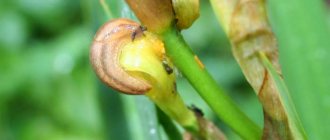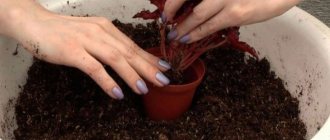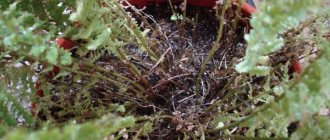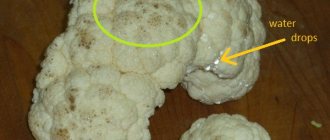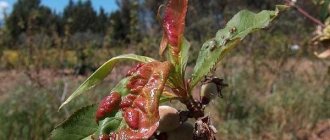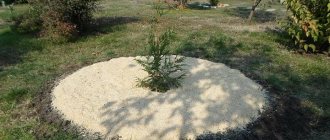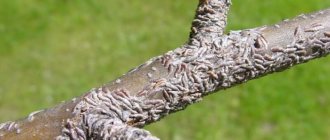Nutritious lily bulbs are loved not only by rodents, but also by smaller pests. In addition, the succulent stems and fleshy leaves of plants are affected by viral and fungal diseases, which spoil the appearance of the flowers and can even completely destroy them.
To cure a lily, you first need to correctly determine the cause of its damage. Read this article to learn how to determine which pest has settled on your beauties, as well as distinguish between fungal and viral diseases.
Fungal diseases of lilies
Lilies are affected by fungal infections that occur in many flower crops. The spread of rot is facilitated by high humidity, improper care, and lack of preventive measures.
Gray mold (botrytis)
Of all fungal diseases, gray rot is the most dangerous. Initially, the disease affects the lower leaves of plants, but very quickly covers all parts of the flower.
Signs
The first signs of gray rot are brown round spots, which during development transform into brown mucous tissue with a gray coating. Gray rot spreads in rainy and damp weather, as well as during sudden temperature changes. Affected lilies do not die, but only slow down in growth and lose their decorative properties.
Control measures
It is difficult to stop the disease, since the pathogen overwinters in bulbs and plant debris. Therefore, before planting, the bulbs must be soaked in a Vitaros disinfectant solution (2 ml per 1 liter of water). When the first signs of the disease appear, the flowers are treated with a 1% solution of Bordeaux mixture or another fungicide (Diskor, HOM, Oxyx) every 1-1.5 weeks.
Fusarium
Fusarium is a rot that affects the bottom of the lily bulb. A plant that develops normally during the growing season dies during wintering. The cause of the disease is dampness, the application of organic fertilizers containing fungal spores.
Signs
Fungal infection begins from the bottom of the bulb. At the point where the scales are attached to it, the lily bulb turns brown and falls apart. It is almost impossible to recognize this disease on a growing flower, since it can develop normally due to supra-bulb roots that are not damaged by the fungus. However, in winter the plant is doomed to inevitable death.
Control measures
Disinfect the soil with copper sulfate or Healthy Soil 2-3 weeks before planting the bulbs. Soak the bulbs themselves for half an hour in a 0.2% solution of the drug Maxim Dachnik. Spray the plantings with a solution of Baktofit or Fitosporin-M once every 1-1.5 weeks.
Cercospora
A disease in which spots appear on the tips of leaves; over time, single lesions increase in size, forming larger lesions.
Signs
If the bulbs are planted too tightly, when the ventilation process is difficult, as well as when there is excessive air humidity, brown-yellow spots with a blackish border may appear on the lily leaves. Depending on the type of Cercospora fungus (the main “culprit” of the spots), they can also be colorless, whitish and spread from the edge to the middle of the leaves.
Control measures
If signs of disease occur, you need to spray the plants with 1% Bordeaux mixture, Abiga-Pik, HOM or Topaz (according to the instructions). In the spring, biological agents should be used as prophylaxis at the beginning of the growing season - Fitosporin-M has a good effect. You can also dilute 2 tablets of Alirin-B in 10 liters of water and spray the lilies once every three weeks.
Anthracnose
Leaf spotting, associated with the activity of a microscopic fungus, is clearly visible on the leaves, and if measures are not taken in time, it can affect the stems and bulbs.
Signs
As with other fungal diseases, rusty-brown spots appear first on the leaves, and in later stages of the disease on the bulbs, around which over time an uneven black border forms, as if the spot is “burning out.”
Control measures
Spotting of fungal origin responds well to treatment with fungicides, for example, Agrolekar (7-10 ml per 10 liters of water) or Chistoflor (same dosage) and the leaves are sprayed with this solution). Before treating plants, damaged leaves must be removed to prevent the infection from spreading. If it “spreads” to the stems, it will be much more difficult to deal with the fungus.
Rhizoctoniosis (sclerotial rot)
This insidious infection can persist in the soil for up to 10 years. Moreover, she is not afraid even of low temperatures.
Signs
Rot affects the lily bulbs, causing a mold coating on them - the mycelium of the fungus develops right inside, between the scales. Moreover, the seedlings of infected bulbs are stunted, twisted or do not sprout at all. Without treatment, plants die.
Control measures
The first choice drugs are fungicides Maxim Dachnik (2 ml per 1 liter of water), Abiga-Pik (40-50 g per 10 liters of water), HOM (30-40 g per 10 liters of water). In addition, lilies can be planted in their original place no earlier than after 4-5 years, ensuring good drainage before planting. Plants that cannot be cured must be dug up and the soil around them replaced.
Pythium
Pythium is a disease of lilies that causes rotting of the roots, as a result of which the development of the crop is disrupted: the plant does not receive enough nutrients and moisture. The affected lily loses its decorative effect and blooms weakly.
Signs
The tops of the leaves turn yellow and the lily dries out. The roots of the bulb become covered with brown spots.
Control measures
Remove affected parts of the plant. Before planting, disinfect the soil with a 0.4% solution of colloidal sulfur, soak the bulbs for half an hour in Vitaros solution (2 ml per 1 liter of water).
Blue mold
Blue mold affects the bulbs during storage.
Signs
White spots of fungal hyphae with a greenish coating on the bulbs. When digging up the bulbs, you may notice that they have turned yellow and their roots have died.
Control measures
Rejection of diseased bulbs. Compliance with storage rules. Ventilation and disinfection of storage.
Penicillosis
Penicillosis affects all parts of lilies and causes them to rot.
Signs
Bulbs, flowers, stems become covered with a green coating. Sick plants are stunted and form weak flower stalks.
Control measures
Follow storage rules. When the first signs appear, etch the affected bulbs in a 0.2% solution of potassium permanganate.
Rust
This disease is transmitted through plant debris contaminated with fungal spores.
Signs
The first signs of the disease are small colorless spots that turn yellow over time. Pads of red spores appear on the surface of the spots. As a result, the stems and leaves of lilies dry out.
Control measures
Remove and burn affected leaves. Spray the plants with Forecast solution (1 ml per 1 liter of water) and regularly feed with potassium-phosphorus fertilizers. Replant lilies in the area where rust-affected bulbs grew, no earlier than after 3 years.
Disease Prevention
The main method of prevention is to use only those varieties of lilies that are resistant to the main diseases of the crop. It is desirable that they be zoned in the intended cultivation region. Planting material must be strong and healthy. You can improve its condition by soaking it in one or another preparation for an appropriate period of time.
The lily should be grown in accordance with agricultural technology
First of all, it is important to maintain spatial isolation both between rows and between plants in a row. It is necessary to choose the best site for the crop, which would not be located in low-lying areas with high humidity.
Watering should be sufficient, but moderate. Fertilizing should be applied in a timely manner, strictly observing the dosage. This especially applies to nitrogenous elements, which in excess quantities provoke increased growth of the vegetative mass. This makes the lily more susceptible to disease.
Viral diseases of lilies
Viral diseases of bulbous plants are spread by insect pests (aphids and thrips) or by flower growers themselves through contaminated garden tools.
Cucumber and tobacco mosaic viruses
A fairly common disease of lilies, which is carried by aphids.
Signs
Cucumber and tobacco mosaic viruses appear as light streaks and ring spots on leaves and flowers. As a result of the defeat, the lily's stem becomes deformed and stops growing.
Control measures
Regularly inspect lilies and remove suspicious leaves, destroy specimens affected by the mosaic. Disinfect garden tools. In order to combat the disease vector (aphids), spray the plantings with Aliot solution (10 ml per 10 liters of water).
Tulip variegation virus
This virus settles inside lily cells. Most often carried by aphids from tulips.
Signs
The variegation virus disrupts the pigmentation of the petals, resulting in flowers with streaks, strokes, and spots of a different color. Diseased bulbs of the next generation decrease in size, plants weaken, and the variety gradually degenerates.
Control measures
Spray the plantings with a solution of Inta-Ts-M (1 tablet per 10 liters of water) to protect them from aphids. Regularly inspect lilies and remove suspicious leaves, destroy specimens affected by the mosaic. Disinfect garden tools.
Rosette disease
The occurrence of this disease in lilies is provoked by a whole complex of viruses.
Signs
Lilies affected by this virus are characterized by thickening and yellowing of the stem and the absence of flowers.
Control measures
Spray the plantings with Inta-Ts-M (1 tablet per 10 liters of water) to protect them from aphids. Regularly inspect lilies and remove suspicious leaves, destroy specimens affected by the mosaic. Disinfect garden tools before any manipulations with bulbs and above-ground parts of plants.
Tips and tricks from experienced gardeners
Many summer residents have been growing similar flowers for years and already know everything about them, so they are happy to share advice:
- In the first year after planting, the buds need to be cut off. For what? This will help the culture retain nutrients for future color.
- If aphids appear, you can get rid of them with a spark, and from beetles with spinosad.
- To protect lilies from pests and diseases, as soon as the first shoots open, treat the soil with a special solution (1 liter of warm water, 1 tablespoon each of soda, copper sulfate, ammonia, mix and dilute in another 9 liters of water).
Thus, in order to wait for flowering, you should not neglect the rules of agricultural technology. Even a novice gardener can grow beautiful, healthy lilies. The easiest to grow are Asian hybrid varieties. Even simpler are water lilies - water lilies. They are often grown in ponds at dachas, and the process itself is a topic for another article.
Pests of lilies
There are about 15 types of pests that attack lilies. These small insects weaken plants and are carriers of viruses. Let's list the most dangerous of them.
Spider mite
This pest feeds on the sap of young shoots, which inhibits the growth of lilies. Red spider mite eggs can live in soil for up to 5 years.
Signs
The lily leaves curl and the plant itself gradually dries out. Upon closer inspection, white eggs and adult red spider mites are visible on the leaves.
Control measures
If a pest is detected, spray the plants with a soap solution, insecticides Inta-Ts-M (1 tablet per 10 liters of water), Karbotsin or acaricides (Antiklesch, Apollo, etc.).
Squeak beetle (lily beetle, bulbous rattle)
The bright red squeak beetle lays pink larvae covered with green-brown mucus on the leaves of lilies, which can strip the plant of almost all its leaves.
Signs
Larvae and adults of the pest visible to the naked eye.
Control measures
Spray the plants with Aliot solution or another insecticide (Inta-Vir, Fufanon-Nova).
Lily fly
The lily fly starts inside an uncolored lily bud. Damage will become noticeable when the fly larva has already done “its job” and pupated in the ground.
Signs
Corroded pistils and anthers of stamens of flowers.
Control measures
Destroy damaged buds. Spray the plants with Aliot solution or another insecticide (Fufanon-Nova, Iskra Double Effect, etc.).
Medvedka
The mole cricket eats the roots, bulbs and stems of lilies.
Signs
The presence of a mole cricket in the area can be seen by holes in the soil. If you notice that the lily is dying, and numerous passages appear on the surface of the earth around the plant, most likely the reason is the defeat of the mole cricket.
Control measures
Set up mole cricket traps in the ground. For example, pits with manure or slate shelters, where the insect will crawl to warm itself and lay eggs. Mole crickets collected in one place will be easy to destroy. In late autumn, you need to dig deep into the soil to destroy the overwintering stages of the pest. The preparations Grizzly (2 g/sq.m), Medvetox (3 g/sq.m), and Thunder (20-30 g/sq.m.) are added to the soil.
Khrushchev (chafer beetle larva)
Like the mole cricket, the mole cricket larva eats the underground parts of the flower, which leads to its death.
Signs
White fleshy larvae are visible in the ground. When damaged, the plant dies.
Control measures
Dig the soil deeply before planting and select beetle larvae from it manually. The same chemicals are used as for mole crickets.
Onion hoverfly
This pest lays eggs on the soil surface in May-June. The eggs hatch into young individuals that burrow into the bulb, causing it to rot.
Signs
At the end of spring - beginning of summer, small black flies begin to circle around the lilies, hovering in flight and making a characteristic gurgling sound. If you notice these pests, they have most likely already laid their larvae in the soil.
Control measures
Spray the plants with Aliot solution or another insecticide (Inta-Vir, etc.). In the fall, dig up the ground and mulch with peat. Before planting, treat the bulbs with Vitaros.
Onion rattle
The second enemy of lilies is the onion rattle or red onion beetle, which resembles a ladybug. It goes into the soil for the winter and appears on the surface at the end of April or early May. An adult beetle of this species is an elongated oval-shaped individual, the size of which is no more than 7-8 cm in length. The abdomen is black, the elytra are orange-red. The legs are red with black spots, the black antennae are shorter than half the body length.
The larva of the onion rattle has a dirty white color, with black dots on the sides. The head and legs are black. The back side of the larva is covered with unpleasant mucus and excrement.
The onion borer damages onions, tobacco, potatoes, hazel grouse, all types of lilies and other plants. Both adult beetles and their larvae cause damage to green spaces by devouring leaves, green seed pods, stems and bulbs. This insidious insect manages to pinch off a tiny piece from many buds in a short time, but this already serves as a reason for the fact that the blossoming flower will be completely spoiled.

